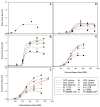UAV Image-Based Crop Growth Analysis of 3D-Reconstructed Crop Canopies
- PMID: 36297713
- PMCID: PMC9611424
- DOI: 10.3390/plants11202691
UAV Image-Based Crop Growth Analysis of 3D-Reconstructed Crop Canopies
Abstract
Plant growth rate is an essential phenotypic parameter for quantifying potential crop productivity. Under field conditions, manual measurement of plant growth rate is less accurate in most cases. Image-based high-throughput platforms offer great potential for rapid, non-destructive, and objective estimation of plant growth parameters. The aim of this study was to assess the potential for quantifying plant growth rate using UAV-based (unoccupied aerial vehicle) imagery collected multiple times throughout the growing season. In this study, six diverse lines of lentils were grown in three replicates of 1 m2 microplots with six biomass collection time-points throughout the growing season over five site-years. Aerial imagery was collected simultaneously with each manual measurement of the above-ground biomass time-point and was used to produce two-dimensional orthomosaics and three-dimensional point clouds. Non-linear logistic models were fit to multiple data collection points throughout the growing season. Overall, remotely detected vegetation area and crop volume were found to produce trends comparable to the accumulation of dry weight biomass throughout the growing season. The growth rate and G50 (days to 50% of maximum growth) parameters of the model effectively quantified lentil growth rate indicating significant potential for image-based tools to be used in plant breeding programs. Comparing image-based groundcover and vegetation volume estimates with manually measured above-ground biomass suggested strong correlations. Vegetation area measured from a UAV has utility in quantifying lentil biomass and is indicative of leaf area early in the growing season. For mid- to late-season biomass estimation, plot volume was determined to be a better estimator. Apart from traditional traits, the estimation and analysis of plant parameters not typically collected in traditional breeding programs are possible with image-based methods, and this can create new opportunities to improve breeding efficiency mainly by offering new phenotypes and affecting selection intensity.
Keywords: breeding efficiency; digital plant volume; high-throughput; plant growth rate; plant phenotyping.
Conflict of interest statement
The authors declare no conflict of interest.
Figures








References
-
- Holman F.H., Riche A.B., Michalski A., Castle M., Wooster M.J., Hawkesford M.J. High Throughput Field Phenotyping of Wheat Plant Height and Growth Rate in Field Plot Trials Using UAV Based Remote Sensing. Remote Sens. 2016;8:1031. doi: 10.3390/rs8121031. - DOI
-
- Wang X., Zhang R., Song W., Han L., Liu X., Sun X., Luo M., Chen K., Zhang Y., Yang H., et al. Dynamic plant height QTL revealed in maize through remote sensing phenotyping using a high-throughput unmanned aerial vehicle (UAV) Sci. Rep. 2019;9:3458. doi: 10.1038/s41598-019-39448-z. - DOI - PMC - PubMed
Grants and funding
LinkOut - more resources
Full Text Sources

